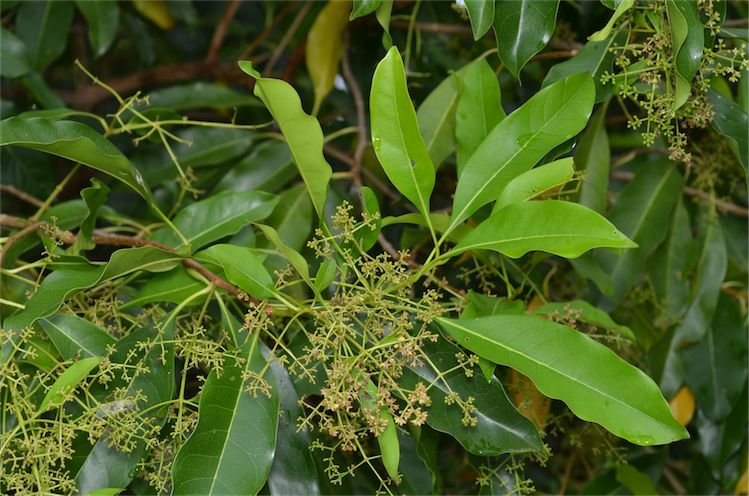Panicle Olive
(Olea paniculata)

Description
Olea paniculata, commonly known as the Panicle Olive, is a species of evergreen tree that belongs to the Oleaceae family. This magnificent tree is native to the Mediterranean region and is known for its ornamental value and the production of high-quality olive oil. With its striking appearance and various beneficial properties, Olea paniculata has become a cherished species among horticulturists, garden enthusiasts, and olive oil producers worldwide. Taxonomy and Nomenclature Olea paniculata falls under the plant kingdom Plantae, division Magnoliophyta, class Magnoliopsida, order Lamiales, family Oleaceae, and genus Olea. The species name "paniculata" is derived from the Latin word "panicula," referring to the plant's distinctive panicle-like inflorescence. Description The Panicle Olive is a small to medium-sized evergreen tree that typically reaches a height of 8-10 meters (26-33 feet) with a spread of approximately 4-6 meters (13-20 feet). Its growth habit is characterized by a dense and rounded crown, making it an excellent choice for ornamental landscaping. Leaves: The leaves of Olea paniculata are oblong or lanceolate in shape, with a glossy dark green color on the upper surface and a paler green shade on the underside. These leaves are approximately 5-10 centimeters (2-4 inches) long and 1-2 centimeters (0.4-0.8 inches) wide, featuring smooth edges and pointed tips. The leaf arrangement is opposite, with a short petiole connecting the leaf blade to the stem. Flowers: One of the most visually striking features of Olea paniculata is its panicle-like inflorescence, which emerges during late spring or early summer. The small, tubular flowers are creamy white to yellowish-green in color and possess a sweet fragrance, attracting pollinators such as bees and butterflies. The flowers are hermaphroditic, containing both male and female reproductive organs. Fruits: Following successful pollination, the flowers of Olea paniculata develop into small, oval-shaped drupes that mature during the autumn months. These drupes measure approximately 1-1.5 centimeters (0.4-0.6 inches) in length and have a purple-black color when fully ripe. Each fruit contains a single, hard stone or pit, which houses the seed. The drupes of Olea paniculata are not typically harvested for culinary purposes like the fruits of other olive species but are valued for their ornamental appeal. Cultivation and Habitat Olea paniculata thrives in Mediterranean-type climates, characterized by mild, wet winters and hot, dry summers. It prefers well-drained soils, including sandy or loamy substrates, and is well-adapted to both acidic and alkaline pH levels. This species is moderately drought-tolerant once established but benefits from regular watering during dry spells. Propagation The Panicle Olive can be propagated through various methods, including seed germination, softwood cuttings, or grafting onto compatible rootstocks. Seeds should be collected from ripe fruits and sown in a well-draining potting mix. Softwood cuttings can be taken in spring or early summer and rooted under controlled conditions. Grafting is commonly employed to ensure the propagation of desirable cultivars and maintain their specific traits. Uses and Benefits Ornamental Landscaping: Olea paniculata is highly valued as an ornamental tree, adding a touch of elegance to gardens, parks, and landscapes. Its compact size, lush foliage, and attractive flowers make it a popular choice for both residential and commercial landscapes. The Panicle Olive can be planted as a specimen tree, in mixed shrub borders, or even in large containers, where its beauty can be appreciated up close. Environmental Benefits: Like other olive species, Olea paniculata has several environmental advantages. Its dense foliage provides shade and can help reduce ambient temperatures in urban areas. The tree also contributes to air purification by absorbing carbon dioxide and releasing oxygen. Moreover, its flowers attract pollinators, supporting local ecosystems and biodiversity. Potential for Olive Oil Production: While the fruits of Olea paniculata are not typically used for culinary purposes, there is growing interest in exploring its potential for olive oil production. Studies have shown that the oil extracted from the Panicle Olive's fruits has a unique flavor profile, with a fruity and peppery taste. Further research and selective breeding could lead to the development of cultivars specifically bred for oil production. Medicinal and Nutritional Value: Olive trees, including Olea paniculata, have a long history of medicinal use. Various parts of the plant, including the leaves and fruits, are rich in bioactive compounds such as polyphenols, flavonoids, and oleuropein. These compounds possess antioxidant, anti-inflammatory, and antimicrobial properties, which may contribute to their potential health benefits. Olive leaf extracts are often used in traditional medicine for their reputed immune-boosting and cardiovascular health-promoting properties. Conservation Status Olea paniculata is not considered a threatened species and is relatively widespread in its native Mediterranean region. However, it is still important to ensure the conservation and sustainable management of this species due to its ecological significance and ornamental value. Conclusion Olea paniculata, the Panicle Olive, is a captivating evergreen tree that combines ornamental beauty with potential practical applications. Its graceful appearance, fragrant flowers, and potential for olive oil production make it a sought-after species among plant enthusiasts and horticulturists alike. Whether gracing a garden or providing environmental benefits, Olea paniculata stands as a testament to nature's aesthetic and functional diversity.
Taxonomic tree:







